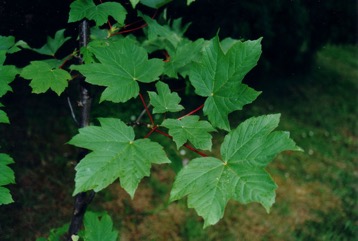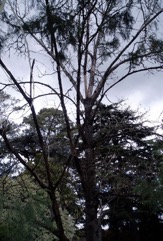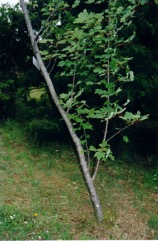Plane-tree maple

It is a temperate plant. A plant native to Europe. It prefers deep fertile soil. It needs to be well drained soil and the plant does best in an open sunny position. It is frost resistant but damaged by drought. It can tolerate salty winds and grow near the coast. It has become naturalised in Tasmania. It suits hardiness zones 4-8. Kyneton Botanical Gardens. Tasmania Herbarium. Arboretum Tasmania.
Also known as:
Beli javor, Hegyi juhar, Javor, Javorfa, Maple, Mock plane, Purple Sycamore, Sycamore maple, Whistlewood
Edible Portion
- Sap, Seeds, Leaves - flavour, Flowers - tea.
Where does Plane-tree maple grow?
Found in: Argentina, Australia, Balkans, Bosnia, Britain, Canada, Caucasus, Czech Republic, Estonia, Europe, Georgia, Greece, Luxembourg, North America, Poland, Romania, Slovakia, Slovenia, South America, Spain, Tasmania, Turkey, United States
Notes: There are about 120-150 Acer species. This one can become invasive.
Status: Children suck the sweet sap from the keys.
Growing Plane-tree maple
Cultivation: It is grown from ripened seed. Seed should be pre-soaked for 24 hours then kept cold at 0-8°C for 2-4 months to assist them to grown. Seed can be sown fresh if green seeds are used. Layering or cuttings can be used.
Edible Uses: Wine is made from the sap of this tree. The sap contains sugar and can be used as a sweetener or concentrated into a syrup by boiling. The keys of the developing seeds have a sweet exudate sucked by children. The leaves are wrapped around food to impart flavour. The leaf buds have been eaten raw.
Production: It is a fast growing tree. Trees can take 25 years to come into bearing from seed. They make good windbreaks in seaside areas. Trees can live for 200 years.
Nutrition Info
per 100g edible portion| Edible Part | Energy (kcal) | Protein (g) | Iron (mg) | Vitamin A (ug) | Vitamin c (mg) | Zinc (mg) | % Water |
|---|---|---|---|---|---|---|---|
| Sap | - | - | - | - | - | - | |
| Seed - Sap | - | - | - | - | - | - | |
| Leaves - flavour | - | - | - | - | - | - |
Plane-tree maple Photos



References
Biocyclopedia Edible Plant Species
Bircher, A. G. & Bircher, W. H., 2000, Encyclopedia of Fruit Trees and Edible Flowering Plants in Egypt and the Subtropics. AUC Press. p 6
Bodkin, F., 1991, Encyclopedia Botanica. Cornstalk publishing, p 42
Brickell, C. (Ed.), 1999, The Royal Horticultural Society A-Z Encyclopedia of Garden Plants. Convent Garden Books. p 68
Bussman, R. W., et al, 2016, A comparative ethnobotany of Khevsureti, Samtskhe-Javakheti, Tusheti, Svaneti, and Racha-Lechkhumi, Republic of Georgia (Sakartvelo), Caucasus. Journal of Ethnobiology and Ethnomedicine.
Bussman, R. W. et al, 2017, Ethnobotany of Samtskhe-Javakheti, Sakartvelo (Republic of Georgia), Caucasus. Indian Journal of Traditional Knowledge Vol. 16(1) pp 7-24
Coombes, A.J., 2000, Trees. Dorling Kindersley Handbooks. p 99
Cronin, L., 1989, The Concise Australian Flora. Reed. p 169
Cundall, P., (ed.), 2004, Gardening Australia: flora: the gardener's bible. ABC Books. p 88
Denes, A., et al, 2012, Wild plants used for food by Hungarian ethnic groups living inthe Carpathian Basin. Acta Societatis Botanicorum Poloniae 81 (4): 381-396
Etherington, K., & Imwold, D., (Eds), 2001, Botanica's Trees & Shrubs. The illustrated A-Z of over 8500 trees and shrubs. Random House, Australia. p 68
Facciola, S., 1998, Cornucopia 2: a Source Book of Edible Plants. Kampong Publications. p 1
Farrar, J.L., 1995, Trees of the Northern United States and Canada. Iowa State University press/Ames p 153
Harris, E & J., 1983, Field Guide to the Trees and Shrubs of Britain. Reader's Digest. p 128
Harter, J.(Ed.), 1988, Plants. 2400 copyright free illustrations. Dover p 3.4, 3.7
Hedrick, U.P., 1919, (Ed.), Sturtevant's edible plants of the world. p 22
Lazarides, M. & Hince, B., 1993, Handbook of Economic Plants of Australia, CSIRO. p 8
Little, E.L., 1980, National Audubon Society Field Guide to North American Trees. Alfred A. Knopf. p 576
Lord, E.E., & Willis, J.H., 1999, Shrubs and Trees for Australian gardens. Lothian. p 45
Łukasz Łuczaj and Wojciech M Szymański, 2007, Wild vascular plants gathered for consumption in the Polish countryside: a review. J Ethnobiol Ethnomedicine. 3: 17
Lukasz, L., 2016, Wild Edible Plants Traditionally Used in Poland.
Marinelli, J. (Ed), 2004, Plant. DK. p 443
Morley, B.D., & Toelken, H.R., (Eds), 1983, Flowering Plants in Australia. Rigby. p 201
Morley, B. & Everard, B., 1970, Wild Flowers of the World. Ebury press. Plate 19
Plants for a Future database, The Field, Penpol, Lostwithiel, Cornwall, PL22 0NG, UK. http://www.scs.leeds.ac.uk/pfaf/
Redzic, S. J., 2006, Wild Edible Plants and their Traditional Use in the Human Nutrition in Bosnia-Herzegovina. Ecology of Food and Nutrition, 45:189-232
Schuler, S., (Ed.), 1977, Simon & Schuster's Guide to Trees. Simon & Schuster. No. 76
Sfikas, G., 1984, Trees and shrubs of Greece. Efstathiadis Group. Athens. p 112
Simkova, K. et al, 2014, Ethnobotanical review of wild edible plants used in the Czech Republic. Journal of Applied Botany and Food Quality 88, 49-67
Sp. pl. 2:1054. 1753
Svanberg, I. et al, 2012, Uses of tree saps in northern and eastern parts of Europe. Acta Societatis Botanicorum Poloniae 81 (4): 343-357
Young, J., (Ed.), 2001, Botanica's Pocket Trees and Shrubs. Random House. p 62